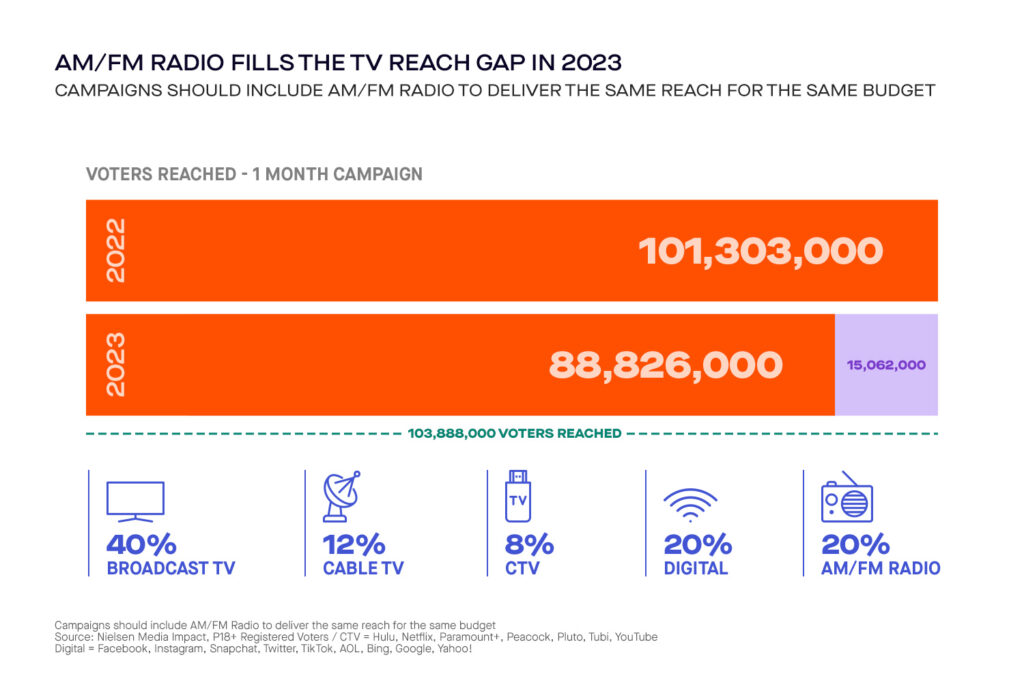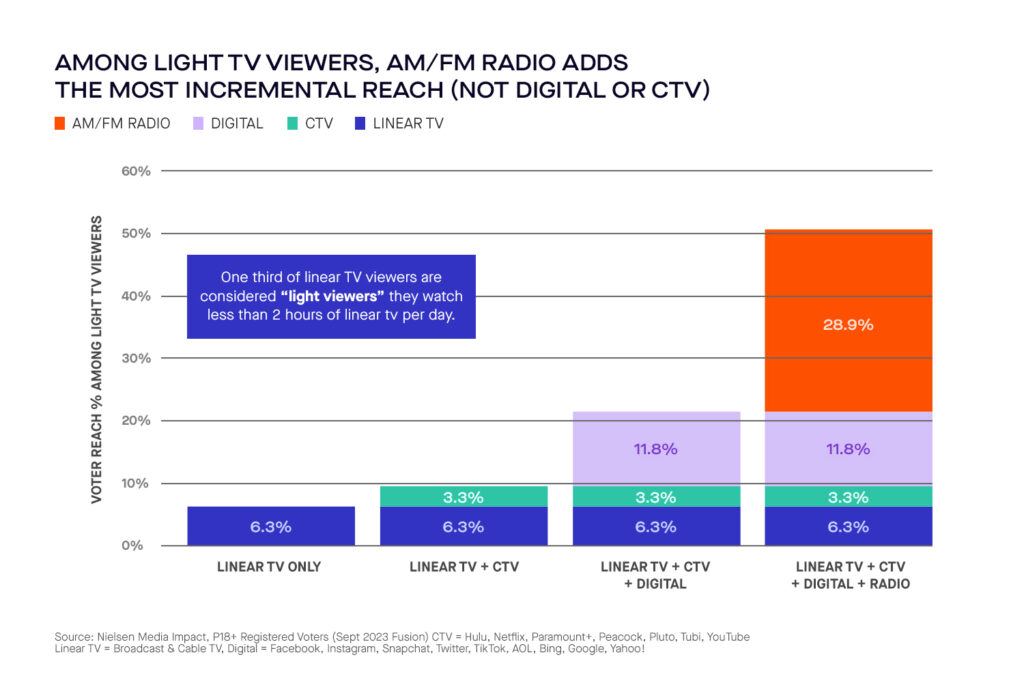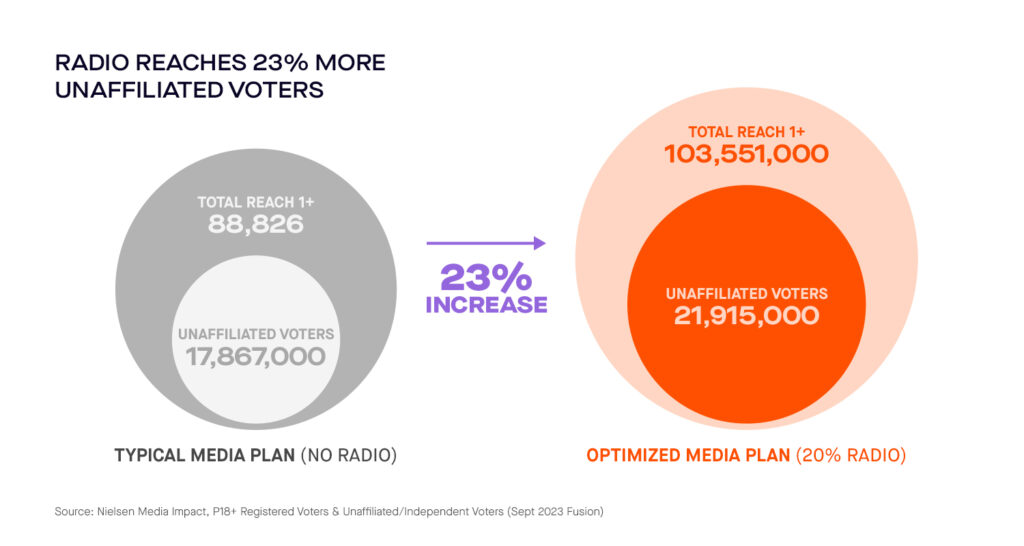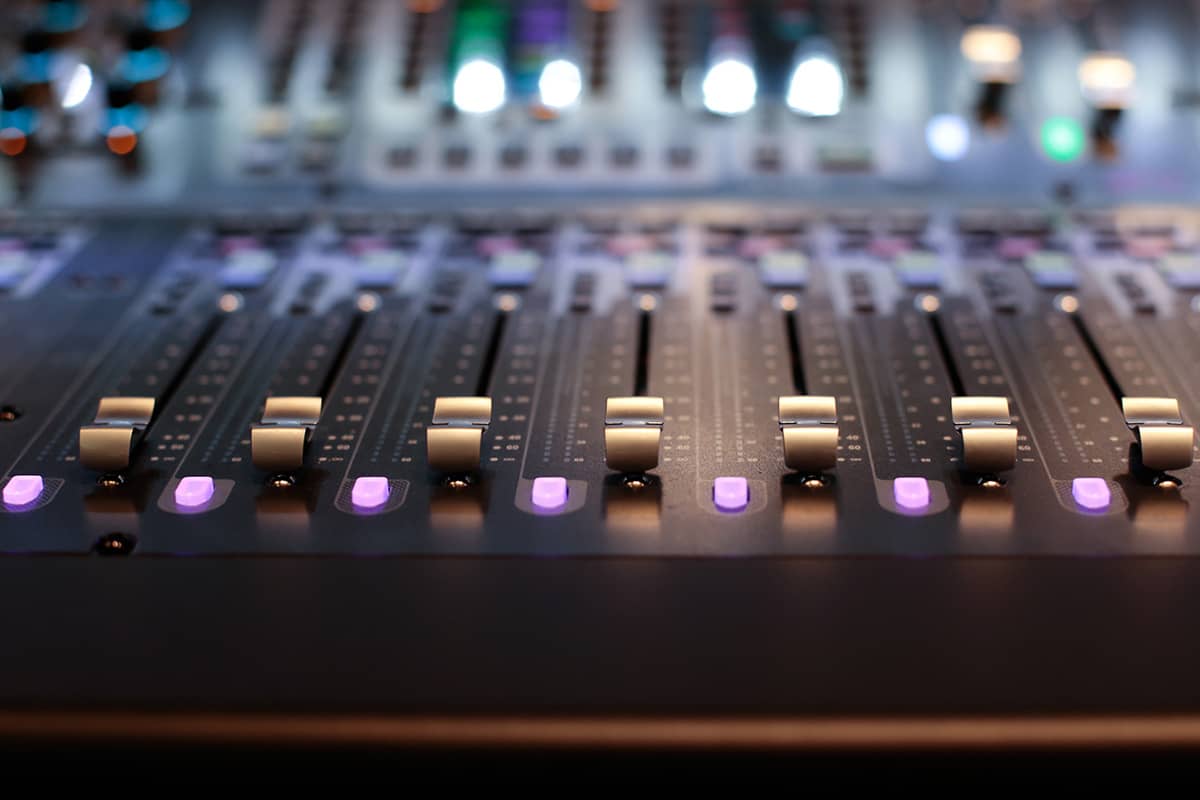Radio Gets the Votes
With many of the 2024 local, state, and federal elections expected to be hotly contested, every bit of exposure will be critical. Radio can provide campaigns with a much-needed edge. By activating Radio, campaigns can connect with key voter groups and amplify other political advertising.
According to a new political study by Nielsen, Radio may be a difference-maker in 2024 contests, helping campaigns extend reach, deliver hard-to-reach demographics, and optimize media plans.
A small strategy shift could make a big difference. If a campaign reallocated 20% of existing ad dollars to Radio, it could reach 17% more voters, according to Nielsen’s new “Optimizing Political Campaigns in November” report, which merges voting behavior and viewership data.
“Incorporating radio into the broadcast mix early and often will result in better outcomes,” noted Jon Blum, Audacy’s Senior Vice President of Strategy, Partnerships and Analytics. “Radio complements TV’s ability to reach undecided voters that are unreachable on TV.”
As recently as 2020, campaigns relied heavily on linear TV to reach voters, but media disruption is upending old political ad tactics. As linear TV viewership declines, campaigns see diminishing returns for expensive investments.
With campaigns under pressure to find alternatives, Radio offers a cost-effective alternative with broad reach across crucial voter groups and the political spectrum. According to Nielsen’s study, Radio has near universal reach (92%) across voter bases, whether Democrats, Republicans or unaffiliated voters.1

“Radio is the secret ingredient that can help a candidate win,” said Haley Teare, Audacy’s VP of Government and Political Partnerships.
While linear TV remains important to political advertising, adding more Radio and introducing it earlier can turbocharge a campaign, extending reach and catching voters who don’t watch TV (or fetch snacks and scroll social media during commercial breaks).
Beginning this spring, savvy campaign advisors and media buyers will prominently include Radio in their advertising strategy as candidates hit the campaign trail.
Radio Reaches Key Voter Groups and “Unreachables”
Radio offers a broad tent to reach key voter groups, even as linear TV’s audience fragments.
Among key voting groups, Radio offers a broader reach than linear TV and connected TV, including women, parents, Hispanic audiences, and people who don’t watch TV.
“These are important constituencies you can reach easily with radio,” Blum noted.
While Radio can help campaigns snare hard-to-reach voters, it also builds incremental reach. For example, one-third of TV viewers are considered “light” and watch less than two hours of TV per day. A political campaign would only reach 6.3% of this audience advertising on linear TV. The campaign could reach 29% more “light” TV consumers by adding Radio.

Radio Slices Through the Clutter and Connects
On an average day, Americans are bombarded with thousands of ad messages, and that hits new highs during political season. If voters are overwhelmed or tune out, political ads miss their mark.
Radio offers a more welcoming environment. According to Nielsen, about 70% of adults said TV is cluttered with too many ads, while 41% said Radio has an adequate ad load.
And Americans are more likely to avoid or skip ads on broadcast and cable TV than radio: About half of all adults surveyed said they frequently skip commercials on cable TV and broadcast TV, while only one-third reported avoiding ads on Radio.
By advertising across Radio formats, campaigns can extend opportunities to engage diverse audiences. While news and talk formats are always popular, Teare said there are opportunities to follow audiences to new genres, including country, Urban, Latin, classic hits, and adult AC stations.
Radio ads also generate high attention rates, which boosts ad effectiveness. A recent study by media agency Dentsu on attention reported that 15- and 30-second radio spots commanded more attention than most other platforms, including TV.
Campaigns can also enjoy a halo effect on Radio thanks to the strong bonds between listeners and their favorite stations. Radio is part of the fabric of their local communities, and listeners have high levels of trust in their favorite AM/FM stations.
Radio Optimizes Political Ad Plans and Delivers
With its proven advantages, Radio deserves a seat at the table. By using Radio early and often, campaigns can maximize the benefits, and it doesn’t require additional investment.
In 2022, Sen. John Fetterman (D-Pa.) deployed Radio to reach voters in the Philadelphia and Pittsburgh markets, which played a critical role in his victory.
Fetterman’s campaign allocated 20% of media dollars to Radio and generated a 10% lift from radio above the local TV campaign, amounting to 676,000 additional voters at no extra cost. Fetterman defeated his opponent, Dr. Mehmet Oz, by less than 300,000, a testament to Radio’s pivotal role in a contested race.
Nationwide, campaigns that have used Radio successfully have launched ads in the spring or summer, well before Election Day.
Blum urges ad buyers and campaigns to include Radio in the earliest stages of media planning to maximize overall campaign reach. That means breaking some old habits. Political campaigns often relegate radio to last-minute buys to activate voter turnout, or when local TV inventory is too expensive. That strategy can be optimized for winning outcomes, and Radio could be the difference-maker, Blum said.
“When campaigns activate a TV plan, they should activate a corresponding radio plan and incorporate it into the mix with TV,” Blum said. “The portion of the population that isn’t reachable via TV could be the swing vote and what throws it over the top for a candidate.”
Case in point: Nielsen’s study noted that if a campaign moved 20% of ad spending to radio, the optimized media plan would connect with 15%more Democratic and Republican voters and 23% more unaffiliated voters.

CASE STUDY
Radio Buoys Warnock in Tight Race
Radio’s potential to help a candidate in a tight race was fully displayed two years ago in Georgia. At the time, Sen. Raphael Warnock (D-Ga.) faced off against Hershel Walker for an open seat, and the Warnock campaign leaned into the power of Radio. In the four-week campaign window, Warnock’s campaign devoted one-quarter of its $4.5 million Atlanta media budget to Radio. The investment paid dividends; Radio produced an 18% lift in registered voters reached with its messaging, equal to 659,000 voters who couldn’t be reached by TV or CTV.

Warnock established a strong Radio presence in the primary process, advertising on Radio in the summer and early fall. While Warnock was victorious, the race was tight; Warnock defeated Walker by 96,613 votes. The campaign’s Radio strategy proved critical in reaching voters early and often. As candidates across the country battle in tight races, Radio can help them win.
“The landscape has changed and you need radio to reach the unreachables on TV,” said Haley Teare, Audacy’s VP of Government and Political Partnerships. “Both studies and real life examples show that radio can be the difference between winning and losing.”
Want to talk more about reaching your target audience?
Let´s Talk1 Source: Nielsen L2 Voter data, Sept 2023, Monthly Reach by media for voters by party
